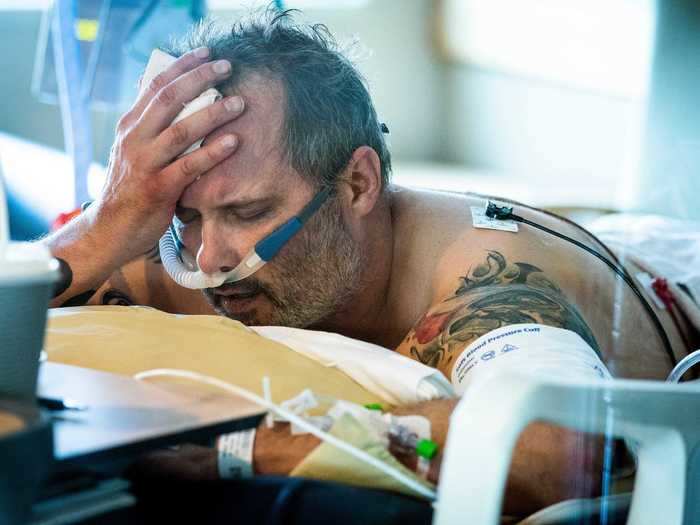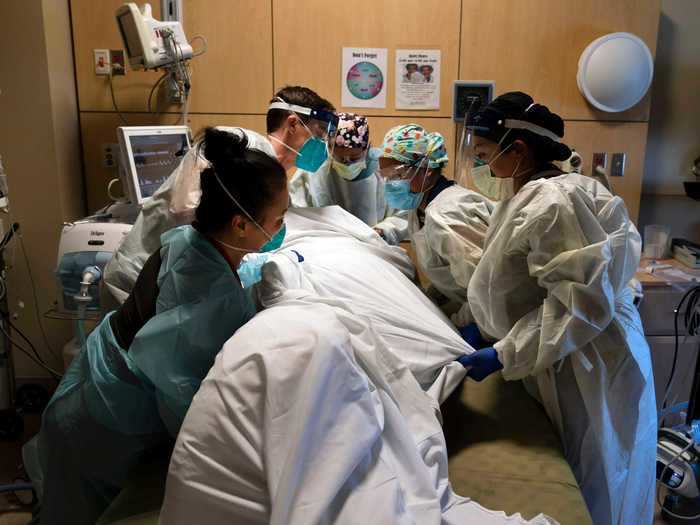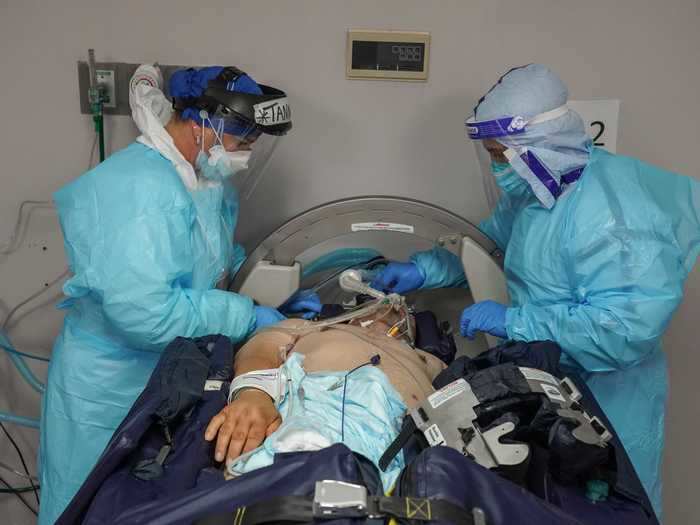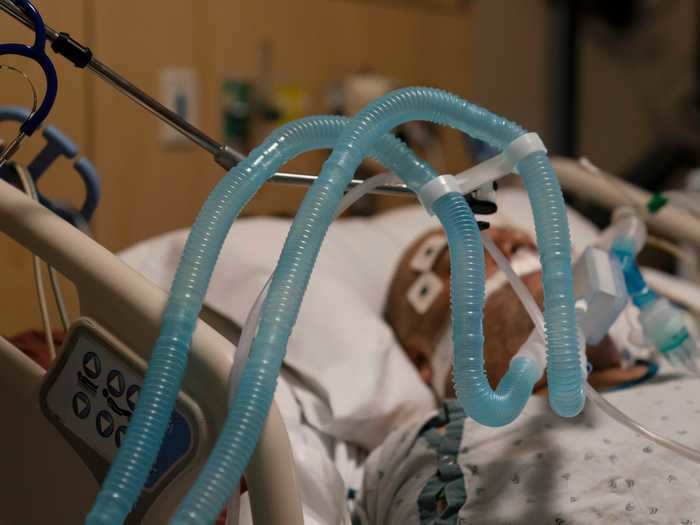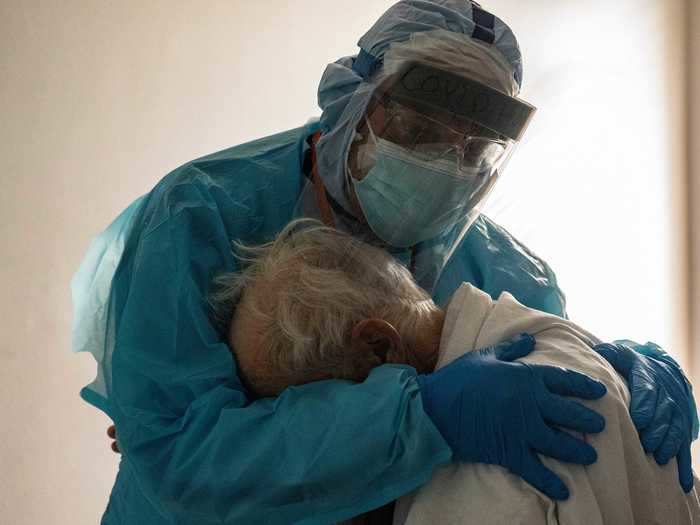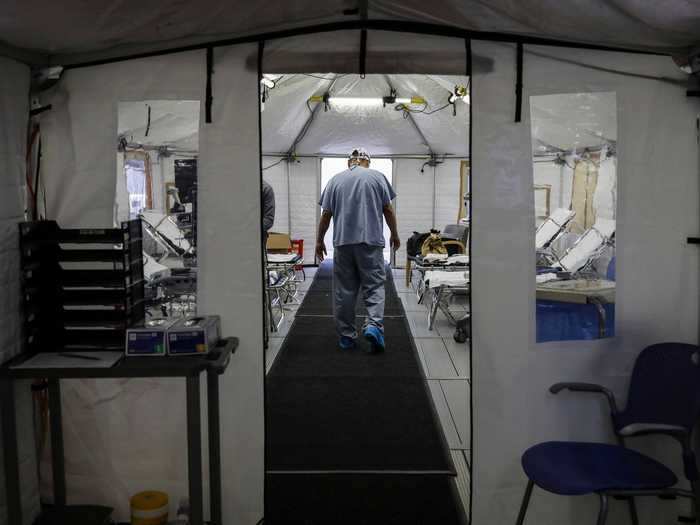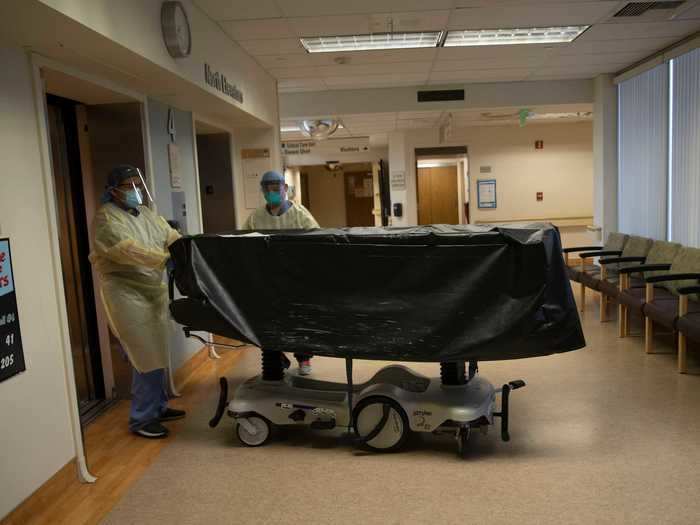Dr. Joseph Varon hugs and comforts a patient in the COVID-19 ICU during Thanksgiving at the United Memorial Medical Center in Houston, Texas.Go Nakamura/Getty Images
- As coronavirus cases continue to surge nationwide, people might not be thinking of what's going on in hospitals as they disregard public health recommendations.
- The harsh reality is that many COVID-19 patients suffer painful symptoms and invasive treatments without loved ones by their side.
- Here's what it looks like to get hospitalized with severe COVID-19.
CDC Director Dr. Robert Redfield warned the public on Wednesday that the coming months could be the "most difficult in the public health history" of the US.
As of Monday afternoon, the US has recorded more than 14.8 million confirmed cases of COVID-19 and more than 283,000 deaths due to the illness. Hospitals across the country are nearing capacity, and while vaccine candidates offer hope for an end in sight, it's bound to be a long winter.
Firsthand accounts by healthcare workers have made it clear that hospitals are overwhelmed and understaffed. Months of watching COVID-19 patients die without their loved ones by their sides have taken a toll on these frontline workers, but most people don't see the human cost of the pandemic with their own eyes.
As Business Insider's Inyoung Choi wrote in an analysis, some Americans are simply too tired to care. Pandemic fatigue has worn down their patience, and mixed messaging by health officials has allowed people to downplay the threat of the virus.
While cases continue to surge nationwide, people might not be thinking of what's going on in COVID ICUs across the country as they're disregarding recommendations to wear a mask, social distance, and keep holiday gatherings small.
These photos show what happens when you get severe COVID-19, and why you don't want to get it now.
COVID-19 patients have described shortness of breath and fatigue that makes it difficult to sit up, stand, or walk across the room.
COVID-19 patient Michael Wright lay in his bed in the ICU at Regions Hospital in St. Paul on November 19.
Leila Navidi/Star Tribune via Getty Images
Other symptoms of COVID-19 include flu-like fever and chills, body aches, and a dry cough.
Neurological symptoms, like headaches, confusion, and loss of taste and smell, occur in more than 80% of hospitalized COVID-19 patients and can persist for month after the initial illness.
Proning, or placing patients on their stomachs, has become a common practice for treating COVID-19 patients who are in respiratory distress.
Medical personnel prone a COVID-19 patient at Providence Holy Cross Medical Center in the Mission Hills section of Los Angeles on November 19, 2020.
Jae C. Hong/AP Photo
In severe cases of COVID-19, most patients experience difficulty breathing by day 5 of their illness and are often hospitalized for shortness of breath. Positioning these patients on their stomachs, or proning, can improve breathing by opening up fluid-filled airways in the lungs.
A small study, published as a research letter in JAMA Internal Medicine in June, found one hour in the prone position was associated with decreased rates of intubation. However, the sample size was just 25 patients and more research needs to be done.
Some hospitals use "rotoprone" beds to rotate their patients into the prone position.
Medical staff members Tanna Ingraham, left, and Gabriel Cervera Rodriguez, right, check on a patient who is on a rotating medical bed in the COVID-19 ICU at the United Memorial Medical Center in Houston, Texas.
Go Nakamura/Getty Images
Some hospitals have "proning teams" designated for flipping patients between their back and stomach all day. Proning patients manually involves four to five staff members, and the delicate process of flipping a critically ill patient can take around 30 minutes.
Rotating medical beds, or "rotoprone" beds, can cut down on the time and human resources required to prone patients.
Some patients eventually require a ventilator and many of them do not survive.
Ventilator tubes are attached to a COVID-19 patient at Providence Holy Cross Medical Center in the Mission Hills section of Los Angeles on November 19, 2020.
Jae C. Hong/AP Photo
A study published in Clinical Infectious Diseases in August analyzed the characteristics and outcomes of 11,721 COVID-19 patients and found the mortality rate increased from 21.4% for hospitalized patients to 70.5% among those who required a ventilator.
Patients with severe COVID-19 cannot see their family, and face the mental toll of loneliness.
Dr. Joseph Varon hugs and comforts a patient in the COVID-19 ICU during Thanksgiving at the United Memorial Medical Center in Houston, Texas.
Go Nakamura/Getty Images
Family members are only allowed to visit in near-death situations, so many patients spend their darkest moments comforted by healthcare workers instead of their loved ones.
In this photo, instead of spending Thanksgiving with his own family, Dr. Joseph Varon showed up to work for the 250th day in a row and hugged a patient in the ICU.
Hospitals have set up extra beds in tents for the overflow of patients.
CA Cesar Merida walks through a temporary tent set up at UMass Memorial Hospital in Worcester, MA on Nov. 11, 2020.
Erin Clark/The Boston Globe via Getty Images
Despite months of planning, hospitals are experiencing shortages of beds and healthcare personnel as cases continue to surge. Field hospitals and mobile morgues are filling up, and the worst may be ahead, the AP reported last week.
More than 282,000 people have died of the coronavirus.
Hospital staff members enter an elevator with the body of a COVID-19 victim on a gurney at St. Jude Medical Center in Fullerton, Calif.
Jae C. Hong/AP Photo

